Save Money With Your Edible Garden

By: Julie Martens
Edible gardens aren't just good for your health, they're also good for your wallet--a well-maintained garden can yield a half-pound of fresh vegetables for every square foot of garden space.
Whether you’re trying to pinch pennies on your grocery bill or just hungering to eat healthier, having your own edible garden is the answer. The beauty of tending a backyard vegetable patch is that you can pick and choose what to grow, allowing you to customize a mix that suits your family’s palate—and gives you the greatest return on investment.
How much can you save?
A backyard edible garden will trim costs from your grocery bill while providing you and your family with the freshest produce possible. According to Bruce Butterfield, research director for the National Gardening Association, a well-maintained garden can produce a half-pound of fresh vegetables for every square foot of garden space. At average market prices, that means a garden returns about $1 per square foot.
Studies conducted by W. Atlee Burpee Co., a mail-order seed company, are even more optimistic. According to Burpee, the average cost-to-benefit ratio of home-grown produce for those who have established gardens is better than 1 to 25. That means every $1 spent on seeds and supplies yields at least $25 worth of vegetables.
Even first-time gardeners will benefit. George Ball, owner of Burpee Co., says that a $10 investment in seeds for tomatoes, beans, bell peppers, lettuce, peas, and carrots, plus $80 for soil, fertilizer, and the cost of building several raised beds, can yield more than $250 worth of veggies and herbs—a substantial portion of the approximately $3,465 the average U.S. family spends on a year’s worth of groceries.
For families that save the harvest, either by freezing, canning, or drying, the cost-benefit ratio climbs even higher. Martha Garway, who tends a 10x10 plot in a Providence, R.I., community garden, freezes much of her summer produce, such as okra, tomatoes, and peppers.
That summer harvest, which costs her $20 for the plot plus the cost of seeds (and she tends to save her own), enables her to “buy only meat and fish through winter—no vegetables,” she says.
Top plants for great returns
For the average gardener in most regions of the country, here are some of the most cost-effective vegetables to grow, and an estimate of what you’ll save over store-bought produce. These figures reflect veggies harvested for fresh eating only; if you freeze or can produce to consume beyond the harvest season, your savings will multiply.
Slicing tomato
Seedling cost: $2.00/plant
Yield: 10-15 pounds tomatoes/plant
Savings: $15-$23/plant
Bell pepper
Seedling cost: $2.00/plant
Yield: 6-8 peppers/plant
Savings: $9-$12/plant
Cucumber
Seed cost: $2.95/packet of 240 seeds
Yield: 10-15 pounds of cucumbers per plant
Savings: $5-$7.50/plant
Bush green beans
Seed cost: $2.95/packet of seeds
Yield: 2.5-3 pounds/5-foot row
Savings: $3.75-$4.50/row
Pole green beans
Seed cost: $2.95/packet of seeds
Yield: 4-5 pounds/5-foot row
Savings: $6-$7.50/row
Leaf lettuce
Seed cost: $2.00/packet of mixed lettuces
Yield: 16 oz. of salad every 3-5 days after leaves mature
Savings: $4 per week
A few vining vegetables, like squash or Malabar spinach, produce abundant yields for the price of a packet of seeds ($2.95). Winter squash types in particular are easy to cure and store, lasting well into spring and offering savings of up to $10-$15 per vine.
Herbs
Herbs offer amazing return. For $1.50, you can buy a 3-inch pot of parsley, chives, oregano, mint, or basil and harvest leaves all season long. With the perennial herbs, like oregano and mint, the harvest continues for years with little maintenance action required. Compare that to “fresh” herbs you’ll get at the grocery for $3 for a 3-ounce packet.
What not to grow
Some vegetables aren’t cost-effective in an edible garden. For instance, you could spend $20 for organic seed potatoes that will yield 15 pounds of spuds from a 20-foot row planting. Compare that with the average price of white potatoes in the supermarket at $1 per pound. Then again, you can’t find Russian Banana fingerlings or Purple Viking potatoes at the grocer, so if you want a specialty spud, grow your own.
Other veggies that don’t pay to grow are ones that are finicky, like celery or asparagus. Both are labor intensive. Onions are relatively cheap to purchase, and it can be difficult to get a large yield of good-size bulbs without a massive garden.
Try growing shallots instead, a gourmet-style onion family member that produces green tops you can harvest like chives and mild flavored bulbs that cost up to $4 a pound at the store.
How big an edible garden?
The median size of an edible garden is about 100 sq. ft., according to the National Gardening Association. For a family of four, a growing space of 200 sq. ft. should keep the family in veggies all summer long. Plan to spend 4 hours a week tending your garden, with 8-12 hours for preparing the planting area in spring, shopping for seeds and seedlings, and sowing crops.
Julie Martens is a writer with 21 years’ experience in the field of gardening. Her bylines appear in magazines such as Nature’s Garden, Country Gardens, and Garden Ideas & Outdoor Living. She recently moved into a renovated 1915 home and is busily working on a new garden.
Used with permission of the NATIONAL ASSOCIATION OF REALTORS®. Copyright 2010.
All rights reserved.